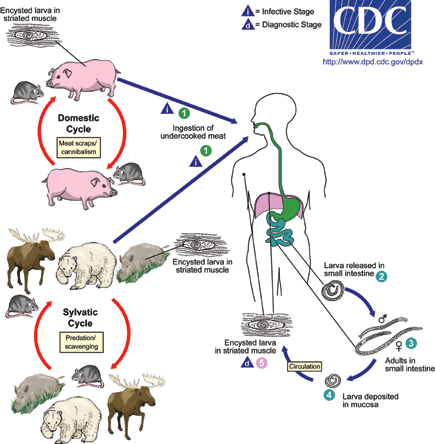Introduction to Diagnostic Medical Parasitology
Essentials
Trichinellosis, a severe disease in humans, is caused by an intestinal nematode, Trichinella spiralis. The infection is transmitted by eating raw or undercooked meat with encysted larvae. Many domestic and wild animals - in temperate zones mainly pigs - serve as a reservoir.

After per oral uptake of infected meat and gastric digestion of the cysts, larvae develop very rapidly in the subepithelial tissue of the small intestine. After four moults and mating of adult worms, gravid female worms (3-4 mm in length) reinvade the mucosa. They start releasing larvae in the mucosa from day 4 post-infection. Larvae (about 100 µm long) enter the bloodstream, are disseminated throughout the body and enter the muscle tissue where they become encapsulated within 4-5 weeks post-infection. The infective larvae (about 10 mm in length) survive for many weeks in the cysts. Their calcification begins after 6-12 months.

Epidemiology
- Trichinellosis is distributed worldwide even in polar zones (there is no free-living parasitic stage which could limit the distribution!)
- Human cases occur sporadically or in outbreaks after a meal of infected meat
- Trichinosis is a zoonosis transmitted between carnivore animals
Pathology
- Main pathology results from inflammatory reactions elicited by invasion of larvae into striated muscle
- In heavily infected patients, cysts may also be found in the brain and lungs
Clinical Findings
- Intestinal stage of infection: no symptoms or diarrhoea and abdominal pain. Fever is rare.
- During the muscle invasion stage, a characteristic periorbital oedema may develop accompanied by fever, myalgia and weakness
- Severity of the disease is related to worm burden
Early characteristic signs: diarrhoea, abdominal pain, less frequently fever, nausea and vomiting
Diagnosis
Diagnostic methods
Parasitological diagnosis
In most cases, parasitological diagnosis is not possible. Muscle biopsy by identifying the larvae is only recommended in cases for which serology is not conclusive.
At the diarrhoeal stage, adults and larvae may be occasionally found in stool samples.
Molecular diagnosis
Molecular diagnosis allows the differentiation of newly described Trichinella species other than T. spiralis for which humans can be an accidental host.
Antigen detection
Tests detecting copro-antigens have recently been developed. They seem to be diagnostically important in the early phase of an infection when serology is still negative.
Antibody detection
Many serological tests (in various test formats, of which ELISA seems to be the most sensitive) are available. The use of excretory/secretory antigens is preferred to crude worm extracts. Immunoblotting can confirm the result of the screening test.
Seroconversion occurs 3–5 weeks after infection. Antibodies titres can persist for years after the acute phase of infection. They do not correlate with the clinical course of infection.
Diagnostic strategies
Diagnosis is based on clinical grounds and on serological tests which have to be selected for the specific diagnostic aim.
Prevention and control
- Cooking meat at safe temperatures. It is essential to use a food thermometer to check the internal temperature of cooked meat
- After handling raw meat, ensure to wash your hands with warm water and soap.
- Freeze pork that is less than 6 inches thick for 20 days at 5°F (-15°C)
- Clean meat grinders after each use.